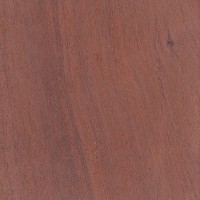 |
Common Name(s): Jarrah Scientific Name: Eucalyptus marginata Distribution: Australia Tree Size: 100-130 ft (30-40 m) tall, 3-5 ft (1-1.5 m) trunk diameter Average Dried Weight: 52 lbs/ft3 (835 kg/m3) Specific Gravity (Basic, 12% MC): .66, .84 Janka Hardness: 1,860 lbf (8,270 N) Modulus of Rupture: 15,650 lbf/in2 (108.0 MPa) Elastic Modulus: 2,132,000 lbf/in2 (14.70 GPa) Crushing Strength: 9,600 lbf/in2 (66.2 MPa) Shrinkage: Radial: 6.3%, Tangential: 9.4%, Volumetric: 16.4%, T/R Ratio: 1.5 |
Color/Appearance: Heartwood color ranges from a light red or brown to a darker brick red; tends to darken with exposure to light. Thin sapwood is a pale yellow to pink.
Grain/Texture: Grain tends to be interlocked or wavy with a medium to coarse texture. Some boards can contain gum pockets or streaks as a naturally-occurring defect. Jarrah can also exhibit a curly figure.
Endgrain: Diffuse-porous; large pores arranged in diagonal rows, few; exclusively solitary; tyloses common; growth rings indistinct; narrow rays not visible without lens, spacing normal; parenchyma vasicentric.
Rot Resistance: Jarrah is rated as very durable regarding decay resistance, and it is also quite resistant to insect attack.
Workability: Jarrah tends to be difficult to machine on account of its high density and interlocked grain. Jarrah also has a moderate blunting effect on cutting edges. Jarrah turns, glues, and finishes well.
Odor: No characteristic odor.
Allergies/Toxicity: Although severe reactions are quite uncommon, Jarrah has been reported to cause eye and/or respiratory irritation. See the articles Wood Allergies and Toxicity and Wood Dust Safety for more information.
Pricing/Availability: Jarrah is a widely distributed timber throughout southwest Australia, and prices for local lumber should be moderate. Prices for imported Jarrah tends to be in the mid range for exotic lumber. Curly pieces, or burl block are likely to be much more expensive.
Sustainability: This wood species is not listed in the CITES Appendices or on the IUCN Red List of Threatened Species.
Common Uses: Flooring, heavy construction, veneer, cabinetry, outdoor furniture, and turned objects.
Comments: Because of its great durability and common occurrence, Jarrah is a useful timber for exterior projects in Australia. Its vibrant red color, and high density add to its marketability for use as a flooring material. Jarrah burl is also prized among wood turners, with its tight knots, swirling grain, and rich colors giving an aesthetically pleasing appearance.
- Blue Gum (Eucalyptus globulus)
- Brown Mallee (Eucalyptus dumosa)
- Coolibah (Eucalyptus coolabah)
- Deglupta (Eucalyptus deglupta)
- Karri (Eucalyptus diversicolor)
- Lyptus® (Eucalyptus urograndis)
- Messmate (Eucalyptus obliqua)
- Mountain Ash (Eucalyptus regnans)
- Red Mallee (Eucalyptus oleosa)
- River Red Gum (Eucalyptus camaldulensis)
- Rose Gum (Eucalyptus grandis)
- Swamp Mahogany (Eucalyptus robusta)
- White Box (Eucalyptus hemiphloia)
- Yellow Box (Eucalyptus melliodora)
- Yellow Gum (Eucalyptus leucoxylon)
Scans/Pictures: A special thanks to Steve Earis for providing the wood sample and turned photo of this wood species.


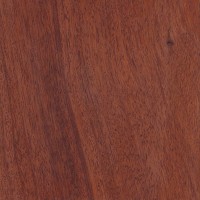
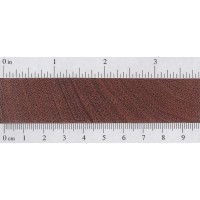
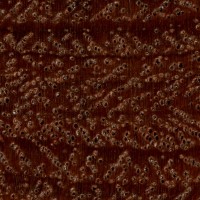
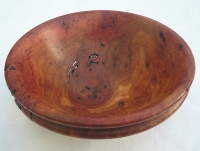



I believe I have some Jarrah though I was told it was Brazilian cherry/ Jatoba when I bought it. It has a brilliant red & scarlet color that becomes more of a deep red when sealed with mineral oil. Has a sort of sweet smell. Extremely dense and heavy despite the small size of the pieces I have.
Was used for roads, as oblong blocks, or ‘Hampton Cheeses’ ( cross-sections of logs, with an iron band around the rim ), or as plank roads. Kerbs were still being replaced with concrete during the 1980s
I just looked up jarrah. I’m american- I don’t expect to see it – but from what I read , I’m thinking it would be impractical to work with hand tools. Am I right
you’d be right, I’m trying to hand plane some slabs of Jarrah for a work bench top. It is by far the hardest thing I’ve tried to flatten. High angle plane sharpened to 16000 still struggles and tears out
Seems to saw ok though, if a bit slow
Hi I was told this is probably Jarrah but it’s not very red! What else could it be?
@TonyRio- Google Marri, Karri and Tuart trees. They are other natives of Western Australia, and could be what you have. All species can be found growing in the same area/forrest as Jarrah,and often hard to distinguish between species when live.
A turned bowl from Jarrah wood, as you see, it is a bit figured as well :).
What is the best finish to use on jarrah wood bowl?
Rubio monocoat Pure
Hi Eric, i have very large natural looking Jarrah feature beams that are looking like they’re starting to fade a little due to the large windows I have near can I oil them os should I stain them
regards Louise
Give em a bit ofo oiling, if in several months they are still discolouring then you can stain them
Please clarify regarding Jarah wood.
at what stage does Jarah cause respiratory and eye irritation. Is it its dust or contact with it. Is it when wet or/ and dry.
Please advise
Simo
Generally, most instances of respiratory irritation are going to come when you inhale the airborne sawdust. There are some exceptions to this, such as with me, as I can have a respiratory reaction (asthma is triggered) just by smelling Western Red Cedar. But I’m guessing with Jarrah, for most people, it will come when inhaling the sawdust. Same goes with eye irritation. Also, wet (green) wood tends to trigger stronger reactions in most categories as well, but dry wood is still an irritant too.
Does polishing and sealing eliminate the irritation risk from Jarah floor
Generally yes, sealing flooring eliminates the allergy risks for all but perhaps extremely sensitive individuals.
But consider that if you are having flooring installed in your house onsite, then there will be a multitude of sawdust generated inside your home no matter how careful the installers are, and airborne sawdust that can linger in the air for a quite some time. The best way to deal with this after the installation is complete is to simply have the air exit the house directly rather than try to capture it in filter media.
Many thanks for the nformation. Regards
I have used a lot of jarrah with no protection whatsoever and no problems.
I just finished two Jarrah end grain chopping boards. A lot of sanding, cutting and routing to flatten. There was an enormous amount of dust. When I took off my disposable N95 mask, it left a white space on my face where the mask had been All dust is bad for you. Wood is also carcinagenic. I also wear a 3M dual respirator with charcoal and dust filters. At the end of the day, my white dust filters in the air intakes were coated with dark brown/red dust from the Jarrah. Trust me, invest now in some type of dust… Read more »
Thanks for the heads up! I’m getting some in two weeks and plan to route out quite a bit.
I have a solid jarrah oval table that is around 40yrs old, however, the timber was seasoned before being made. My lids used it for a few years with their drunken mates and the table has scuff marks and gouges aver it.
I have started to sand it, however not sure how to finish it. SO far there still are scuff marks, (guess I gotta sand further.
I would like a matte finish. Better to go oil or some sort of varnish?
Any suggestions?
This is a very tough wood–are you sure it is Jarrah (Eucalyptus marginata) or related species.
While you may succeed for old wood you have a very difficult task in front of you. If this was fresly cut young wood that would be a different story.
Hi Mary
Hot items will leave marks on the coatings.
To refinish, you need to completely sand off the old coats. Use a hand held sanding machine.
As it is very old jarrah (40 yrs old), keep it rustic and use it. Show off the beauty of jarrah without covering up with table cloth.
Use coastal for hot items.
Try Bee Wax or similar to finish off after sanding.
C Ong
I have a solid jarrah oval table that is around 40yrs old, however, the timber was seasoned before being made. My lids used it for a few years with their drunken mates and the table has scuff marks and gouges aver it.
I have started to sand it, however not sure how to finish it. SO far there still are scuff marks, (guess I gotta sand further.
I would like a matte finish. Better to go oil or some sort of varnish?
Any suggestions?
If the dinning table and chairs are made of solid jarrah, it’s a bargain for $400. Grab it if in good condition.
Buying a house and the seller has a dining size table and 6 chairs that they say are made out of Jarrah wood (I thought he wrote Jarcha, but when I googled it, it told me it’s Jarrah. Would $400 be a reasonable price to buy it from them? I’m in the San Francisco Bay Area.
What does jarrah wood smell like
I need to know as soon as possible
Did you ever get a reply? I burn Jarrah offcuts and cut up lengths picked up from curb throw-outs during collections weekends. I find the smell pleasant, but make sure it gets a fast start-up with a strong flame and a good draw up the chimney and that the smoke is drawn away from you and pets. Also check that the timber has not soaked up liquids such as oil and only attempt tp burn dry timber.
Still don’t know if he got a reply do we?
Just bought 4 Jarrah reclaimed sleepers and need to drill around 6 holes,just wondering this ..which impact driver would be the best one to use ?
many thanks…
Ryan,
Take a clean slice with a miter saw off the endgrain of the board in question, and then clean it up with some very fine grit sandpaper and take a look under a magnifying glass. It should be easy to rule out Jarrah: the pores would be arranged in zig-zag diagonal rows, as pictured above, which is not found in Mahogany.
I have a piece of hardwood that looks a lot like Jarrah or a rare piece of mahogany. It has an oily finish to it, similar to teak but with out the rubbery smell. Any body know what it might be?
thankyou Ryan, Ohio
Take a clean slice with a miter saw off the endgrain of the board in question, and then clean it up with some very fine grit sandpaper and take a look under a magnifying glass. It should be easy to rule out Jarrah: the pores would be arranged in zig-zag diagonal rows, as pictured above, which is not found in Mahogany.
First of go back to your high school physics/chemistry days and look up how to find the density of most anything (including yourself.) the amount of that this wood or you displace in water is the density of that substance! A famous science story goes that Archimedes was ask to tell the king if the Golden crown that he was sold was real gold or a fake. Archimedes was taking a bath and the idea struck him that all he needed to is to place the golden crown in water when he saw the water rise as he entered the… Read more »
i thought that was Einstein. He discovered E=mc^2 in the bath